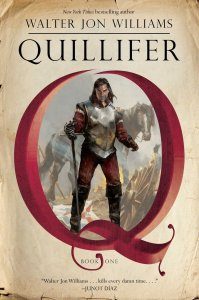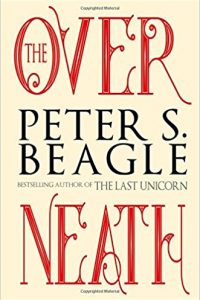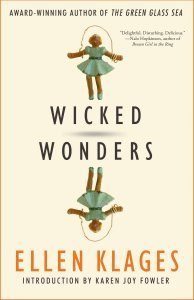Gary K. Wolfe reviews Jeffrey Ford
 In his brief afterword to ‘‘Relic’’, possibly the most brilliant of the 20 stories collected in his Crackpot Palace, Jeffrey Ford notes that the book ‘‘has many secret passageways that connect its rooms, so that two tales told in different styles and seeming to have different concerns might actually be secretly linked through image or idea.’’ While this sounds a bit like a friendly gauntlet thrown down to readers trained in the corridor-like fictions of, say, Gene Wolfe, it’s also a fair clue as to how to approach Ford, an author whose fiction ranges from the dreamlike and mythical to the almost directly autobiographical, and who treats genre materials as though they were pizza toppings rather than rules of engagement – or, perhaps more aptly, like musical lines around which to improvise. It may be no coincidence that he mentions the great tenor sax improviser Lester Young as ‘‘perhaps my favorite musician of all time.’’ ‘‘The Relic’’ itself is essentially a set of linked tales or improvisations revolving around a remote church, whose only claim to fame is an obscure saint’s relic – a mummified foot – along with the priest whose mission is to protect it, the Sister who assists him, a visiting divinity student, and a few later visitors, each with their own tales. But the priest isn’t really a priest, the Sister (apparently) isn’t really a nun, and the student isn’t really a student; their conflicting and overlapping tales, none fully reliable, begin to describe the shape of another story altogether, somewhat as the painter Arcimboldo (another artist Ford cites, in his note to ‘‘The Coral Heart’’) assembled his fish and fruit and veggies into human visages.
In his brief afterword to ‘‘Relic’’, possibly the most brilliant of the 20 stories collected in his Crackpot Palace, Jeffrey Ford notes that the book ‘‘has many secret passageways that connect its rooms, so that two tales told in different styles and seeming to have different concerns might actually be secretly linked through image or idea.’’ While this sounds a bit like a friendly gauntlet thrown down to readers trained in the corridor-like fictions of, say, Gene Wolfe, it’s also a fair clue as to how to approach Ford, an author whose fiction ranges from the dreamlike and mythical to the almost directly autobiographical, and who treats genre materials as though they were pizza toppings rather than rules of engagement – or, perhaps more aptly, like musical lines around which to improvise. It may be no coincidence that he mentions the great tenor sax improviser Lester Young as ‘‘perhaps my favorite musician of all time.’’ ‘‘The Relic’’ itself is essentially a set of linked tales or improvisations revolving around a remote church, whose only claim to fame is an obscure saint’s relic – a mummified foot – along with the priest whose mission is to protect it, the Sister who assists him, a visiting divinity student, and a few later visitors, each with their own tales. But the priest isn’t really a priest, the Sister (apparently) isn’t really a nun, and the student isn’t really a student; their conflicting and overlapping tales, none fully reliable, begin to describe the shape of another story altogether, somewhat as the painter Arcimboldo (another artist Ford cites, in his note to ‘‘The Coral Heart’’) assembled his fish and fruit and veggies into human visages.
Ford is, in brief, a master trickster, and part of the fun of reading his most characteristic tales consists of waiting for the moment when the narrative goes off the rails entirely, or discovering that we were on different rails all along. The lead story, ‘‘Polka Dots and Moonbeams’’ (a title taken from the old Burke-Van Heusen standard) begins as a jazz-inflected 1950s roadhouse-hipster tale, but soon introduces oddities like drinks called gin wrinkles, an ominous character offering a mysterious hypodermic needle as payment for a murder, and – most significantly, it turns out – references to driving out into the desert ‘‘to watch the stars fall.’’ The story develops its own internal logic, but not the one we were expecting. Similarly, ‘’86 Deathdick Road’’ begins with the narrator and his wife, as something of a lark, traveling to a country house to meet ‘‘the smartest man in the world,’’ who offers to answer any question for $50. It sounds like the setup for a John Collier story, and in some ways it is: as soon as the narrator steps out back for a smoke, he finds himself involved with attack owls, an old woman’s endless anecdotes, and a sudden blizzard – not to mention the treachery of the smartest man himself. The ending may not be as satisfactory as many of Ford’s, but it does gather in the strings.
The narrator’s wife’s name in ‘’86 Deathdick Road’’ is Lynn – the same as Ford’s – and the name serves as a marker for a number of stories, usually set in New Jersey, that are consistently among Ford’s most compelling – those which, for lack of a better term, fantasticate the mundane. ‘‘Down Atsion Road’’, another tale with a road in the title (roads recur a lot in Ford’s stories), invokes New Jersey legends in the tale of a reclusive folk artist, while ‘‘The Double of My Double Is Not My Double’’ (doppelgängers are another recurrent theme) begins with Lynn checking out sales in a suburban mall when the narrator encounters his double, who complains of being tormented by his double, an evil shapeshifter who is not the narrator himself, as we might expect, but another, more ominous projection of his psyche. It’s one of the lighter pieces in the book, but plays with the notions of projection and identity almost as shrewdly as Ford’s classic Kafka tale ‘‘Bright Morning’’. ‘‘Every Richie There Is’’ concerns an annoying and long-winded neighbor dying of cancer (another character who tells rambling tales), while ‘‘The War Between Heaven and Hell Wallpaper’’ describes a series of dreams, one depicting the psychomachia of the title, the other sounding a lot like a famous Caspar David Friedrich painting, as well as the narrator’s discussions with his wife Lynn about their possible sources. ‘‘Glass Eels’’, another New Jersey tale, recounts an incident from the illicit trade in these eels (sometimes called elvers).
Sometimes Ford seems to want to explore more purely within genre forms, and the results, while sometimes less innovative, are no less fine examples of craft, and often pretty playful. ‘‘Sit the Dead’’ again begins with a convincing domestic setting, but segues into a rather spectacular vampire tale, while ‘‘The Hag’s Peak Affair’’ is a ready-made SF horror movie, complete with secret government installations, a deserted village, and a grotesque, if tragic, monster. ‘‘Daddy Longlegs of the Evening’’ is something of a hoot, as if John Cheever had been a Weird Tales writer back in the ’40s and invented Spider-Man to boot. ‘‘Dr. Lash Remembers’’ is a steampunk tale actually involving steam, and a hideous plague that erases ‘‘the boundary between imagination and memory,’’ a boundary that fascinates Ford in all sorts of ways. Ford moves more purely toward SF with ‘‘After Moreau’’, a pointed take on the Wells novel narrated by Hippopotamus Man (who ‘‘can say without question that Moreau was a total asshole’’), and ‘‘The Seventh Expression of the Robot General’’ (the title refers to facial expressions), a strong antiwar fable that recalls the surreal SF war stories of David Bunch. ‘‘The Dream of Reason’’ nearly moves into Ted Chiang territory, with its imaginary science in an imaginary cosmology (gases like ‘‘carkonium’’ and ‘‘tarsus margolium’’), but features a scientist following a version of the scientific method experiments within this context. Like some of Chiang’s more intellectual stories, it’s an impressively ingenious performance more than a deeply human tale.
There’s a similarly impressive cosmology in ‘‘Daltharee’’, which conflates several SF notions in the idea of microscopic cities-in-bottles – Sturgeon, Ray Cummings, even Superman (which Ford acknowledges in his note) – but also recalls elements of Ford’s own ‘‘Annals of Eelin-Ok’’, and turns out to be surprisingly touching, even if (as Ford cheerfully admits) it doesn’t quite add up. By the time we get to ‘‘Ganesha’’ and ‘‘Weiroot’’, we’re back in the mythological territory that Ford has sometimes explored (Hindu mythology in the former case, the Greek underworld in the latter), and ‘‘The Coral Heart’’, with its magical sword that turns victims to coral, is perhaps the most straightforward fantasy in the collection – it’s the sort of lush, horror-tinged fantasy reminiscent of Clark Ashton Smith when he was in control of his language. Finally, one of the most haunting tales in the book is essentially a ghost story, set in the Depression-era Susquehanna Valley. A young coroner is faced with the mystery of a beautiful young woman found floating in a creek, whose body shows no signs of decay (sounding much like Millais’s Ophelia), and whose face seems identical to a portrait from four decades earlier. While the story revolves around the coroner and his uneasy relationship with the detective on the case, it vividly evokes its time and place, and maintains an elegant, precise balance between the fantastic and the real. In fact, one sentence might be a textbook example of such balance: before beginning his examination, the young coroner ‘‘turned to her and saw her smile.’’ Reading that last word as a verb rather than a noun changes the scene utterly, and is perhaps, at the level of simple grammar, a hint of the sort of verbal magic that Ford works throughout these tales. Crackpot Palace is the work of a writer who knows where to look for that magic, and who is firmly at the forefront of those writers, emerging mostly during the last couple of decades, who seem utterly comfortable with inventing their own genres as they go along.







